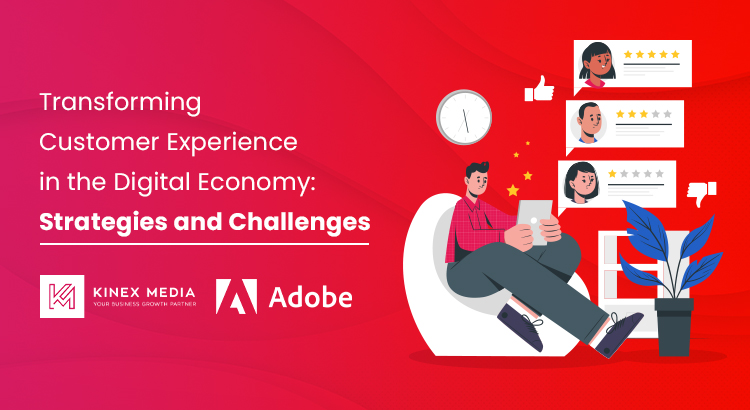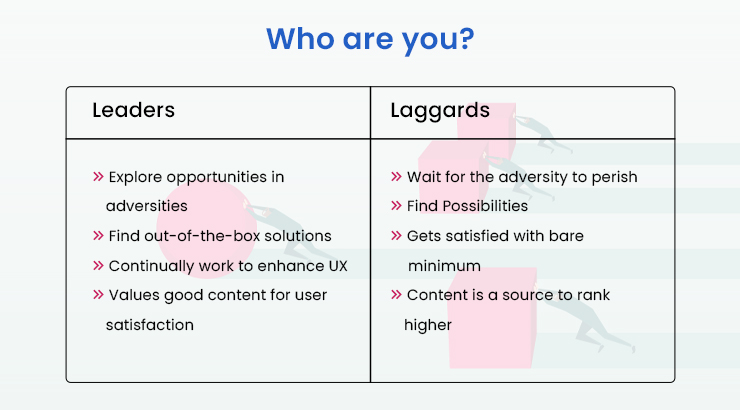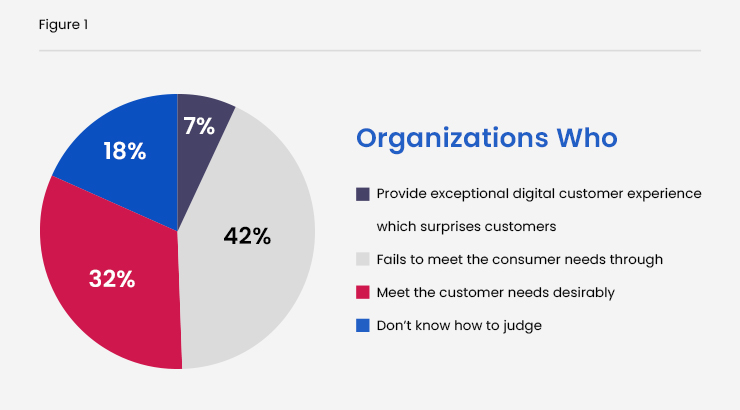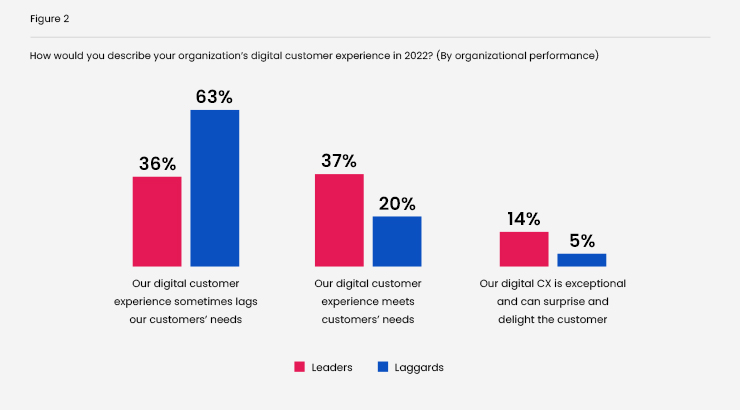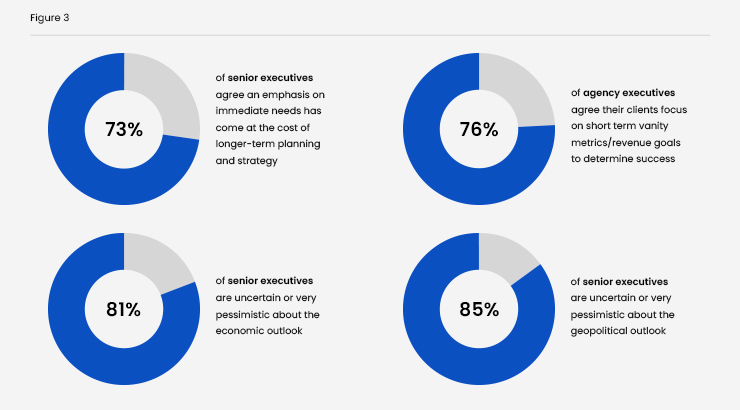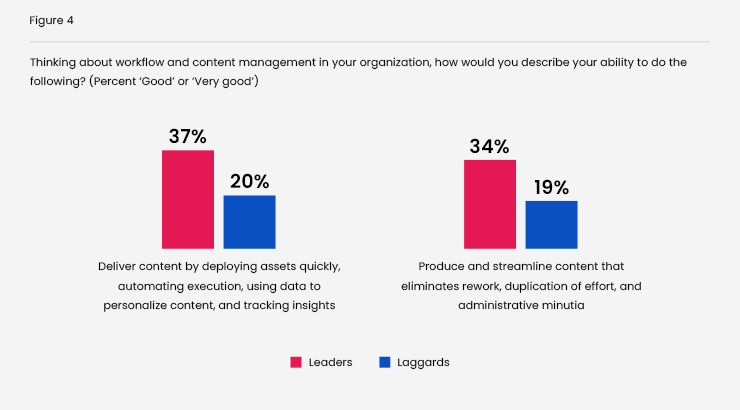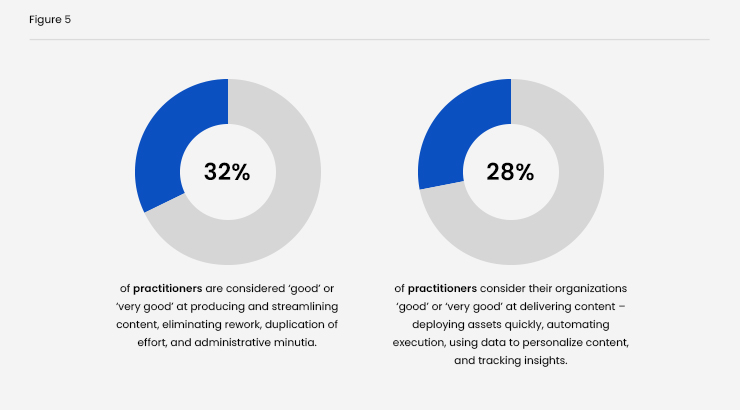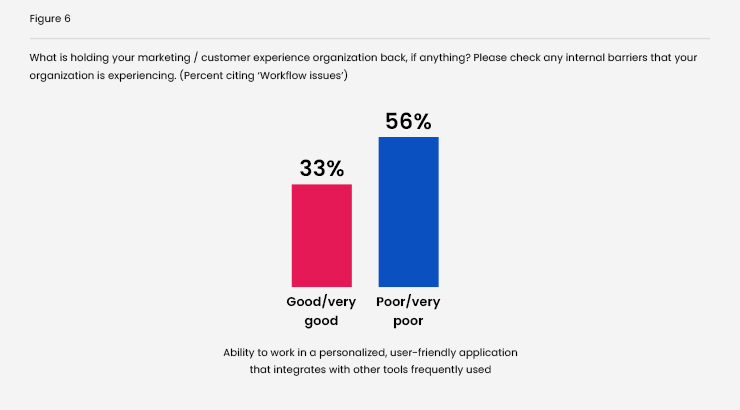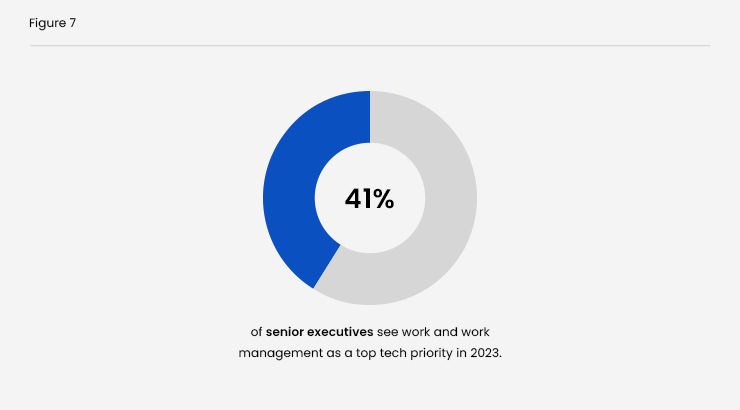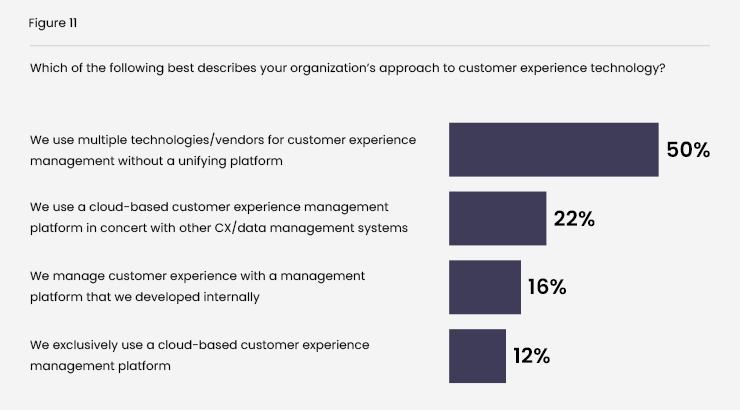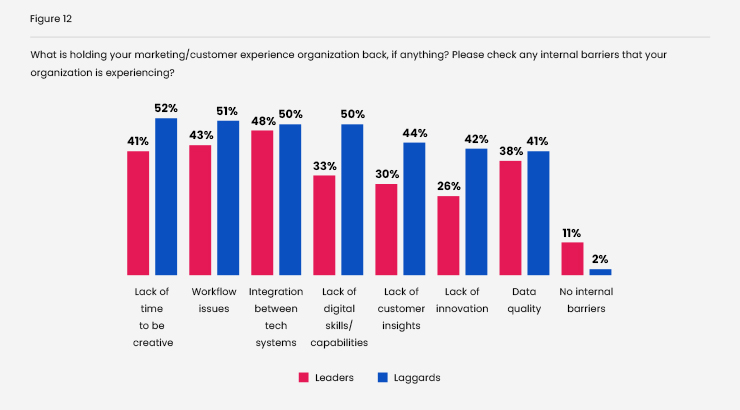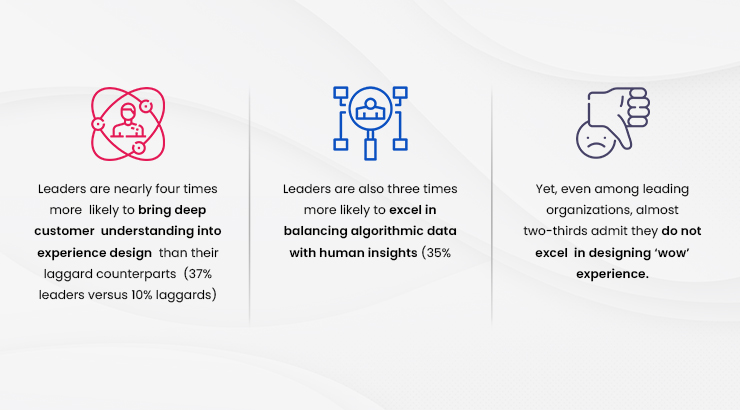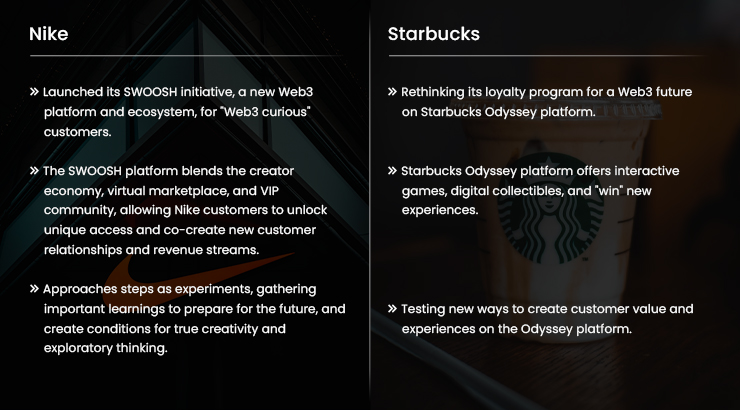We are in a new world of endless possibilities where engagement in digital spaces is becoming more immersive. The Digital Economy is set to grow, and customer experience expectations are continually rising. The Adobe Digital Trends study has been tracking these changes since 2006, noting the emergence of new technologies and platforms to meet these evolving expectations.
Customer experience is key to building trust and earning loyalty, and the strongest experiences require empathy, imagination, and creativity. The study surveyed over 9,000 marketers and CX professionals globally to compare leading and lagging organizations and explore links between commercial performance and customer experience maturity.
The Rising Bar of Customer Experience: Why Organizations Must Keep Up?
The pandemic led to a significant digital transformation resulting in a rise in customer expectations across the board.
- As per a survey, 89% of senior executives agree that customers constantly reset their expectations based on their best omnichannel marketing experiences.
- However, only 7% of practitioners consider their organization’s digital customer experience to be exceptional. About 42% of organizations believe their customer experience sometimes falls short of customer needs.
- The risk of having a poor customer experience (CX) is concerning for businesses in 2023.
- Building customer trust is critical to a positive CX, particularly for Millennial and Gen Z consumers. Trusted brands are likely to receive more spending from customers.
- More than 50% of customers say they won’t buy again from companies that violate their trust.
- Every CX experience earned or lost affects customer trust, making the CX stakes high.
In 2023, the best experiences will be provided by organizations that combine data with human insight to anticipate and fulfill customers’ needs with emotion and feeling. These leaders in customer experience will allow their teams the time, process, and environment to design experiences that foster strong customer relationships and employee satisfaction. Although some organizations may face challenges such as budgetary and staffing constraints, creativity can help them outmaneuver competitors and deliver exceptional experiences with the help of their people, processes, and technologies
Balancing Short-Termism & Long-Term Strategy: The Importance of Prioritizing Customer Experience
- 73% of senior executives agree that focusing on immediate challenges has led to a neglect of long-term planning and strategy.
- Short-termism is more common among lagging organizations, but it is still prevalent.
- Short-term measurement strategies contribute to the problem.
- 76% of agency executives say their clients focus on vanity metrics or quarterly revenue goals instead of longer-term indicators like brand saliency or customer lifetime value.
- Short-termism is understandable given the uncertainty and pessimism about the geopolitical and economic outlook.
- In challenging market conditions, it is even more critical to plan for the future to fend off competitors and defend market share.
- To be successful, organizations must prioritize their customer experience to protect their existing customer base and build brand loyalty.
Maximizing Existing Technology Stacks for Enhanced Customer Experience in the Digital Economy
- A study indicates that many organizations are not utilizing their existing technology stacks to the fullest.
- Around 49% of agency-side staff revealed that their clients have AI or ML functionalities but are either not using them or are unaware of their usage.
- Almost half (48%) of senior executives plan to modify their current use of marketing or data technology to increase its impact in response to macroeconomic issues.
- Organizations must define a clear customer experience (CX) course and have well-defined plans to make the most of their technology investments to achieve success.
- Rebecca Wooters, Chief Digital Officer at Signet Jewelers, emphasizes the importance of innovating and improving the customer experience in real-time at every stage of the customer journey to remain the world’s largest diamond retailer. They are also planning to utilize AI to support decision-making and enhance the Connected Commerce experience.
Overcoming Content Demand Challenges for Brands
- Meeting the increasing content demands has become a key challenge for brands due to rising customer expectations.
- Brands struggle to sustain their presence across preferred channels and respond to real-time interactions.
- 89% of senior executives indicate significant increase in the demand for content to deliver personalized, emotionally-resonant experiences.
- Efficient translation of customer insights into creative content requires full alignment of people, processes, and technology.
- Collaboration across teams is essential to minimize inefficient creative administration and edits.
- The organization must be configured to adapt to changing conditions and correct course when necessary.
Check out these blogs to learn more about how to optimize your digital presence:
Opportunities for Better Planning and Personalization
- Only 33% of practitioners consider their organization to be ‘good’ or ‘very good’ when it comes to planning, scoping, prioritizing, and assigning content tasks for achieving measurable outcomes.
- Leaders are twice as likely as their laggard peers to view their content planning as ‘good’ or ‘very good,’ at 44% versus 20%.
- There is still plenty of room for improvement in content strategy, even among leaders.
- Organizations must avoid producing content for its sake, instead of creating a crystal-clear understanding of the client’s role in each stage of the buyer’s journey and its relationship with business strategy.
- Understanding customers’ preferences and tailoring content cadence and substance to each interaction is essential.
- Content should be served across relevant and helpful channels at the right moment.
Improving Content Operations for Greater Efficiency
- Majority of organizations have room for improvement when it comes to accelerating content production times and increasing content speed to market.
- Only 32% of practitioners are considered ‘good’ or ‘very good’ at producing and streamlining content, eliminating rework, duplication of effort, and administrative minutia.
- Only 28% of practitioners consider their organizations ‘good’ or ‘very good’ at delivering content – deploying assets quickly, automating execution, using data to personalize content, and tracking insights.
- Leaders are ahead of laggards in their content production speed and efficiency, but most still struggle.
- Only 34% of leaders consider their organizations ‘good’ or ‘very good’ at producing and streamlining content efforts compared to 19% of laggards.
- Only 37% of leaders consider their organizations ‘good’ or ‘very good’ at rapid asset deployment, automated execution, and data-led personalization, versus just 20% of laggards.
Content and Workflow Management
- Workflow issues are a major internal barrier for 43% of practitioners, hindering their ability to meet customer needs.
- Marketing teams face the challenge of working on 600 to 800 pieces of promotional content simultaneously, requiring streamlined operations and faster time-to-market.
- Companies can conduct workflow audits, evaluate processes, and identify pain points to optimize operations and human resource structure.
- Companies can integrate user-friendly applications to accelerate workflows, reducing the likelihood of facing workflow issues by 33% compared to those who report poor or very poor usage of such technologies (56%).
- 41% of senior executives see work and work management as a top tech priority in 2023.
- Cotton On Brands uses content workflow management technology to manage its store footprint expansion in the Asia Pacific region.
- Robert Hede, the Head of Customer Experience at Cotton On Brands, emphasizes the importance of having a platform that brings everything together, allowing team members to communicate and work seamlessly.
Real-Time Customer Insights: The Key to Staying Ahead of Leading Competitors
Nearly half of organizations (46%) lack access to real-time data for collecting, organizing, governing, and surfacing critical customer insights. Lagging organizations are particularly prone to this, with just 37% having real-time data compared to 61% of leading organizations. This makes them half as likely to conduct real-time individual-level tests compared to leading competitors. Unfortunately, less than a quarter of senior executives consider the real-time activation of customer data a top priority in 2023, which could be a hindrance in serving customers’ needs at the moment. To keep up with leading competitors and serve customers effectively, organizations need to understand their customers’ real-time needs and spot new opportunities.

- By utilizing customer data and AI-fueled predictive modeling, organizations can anticipate their customers’ behavior in the future and design experiences to meet their needs, which could result in transcending their expectations with in-the-moment, personalized brand interactions.
- However, only 9% of organizations are currently personalizing content based on intent or prediction, according to a study. This indicates that the majority of organizations are still in the early stages of personalization maturity.
- 18% of organizations personalize content based on historical customer data, while 24% rely on broader segment generalizations to tailor experiences.
- Although the percentage of organizations personalizing content based on intent or prediction is higher among leaders (17%) than laggards (4%), the numbers are still limited.
- These findings suggest that most organizations have yet to fully leverage customer data to deliver real-time personalized experiences and are still working their way up the personalization maturity curve.
- The good news is that the study indicates a high probability of seeing substantial progress soon, as organizations recognize the importance of personalization in delivering exceptional customer experiences.
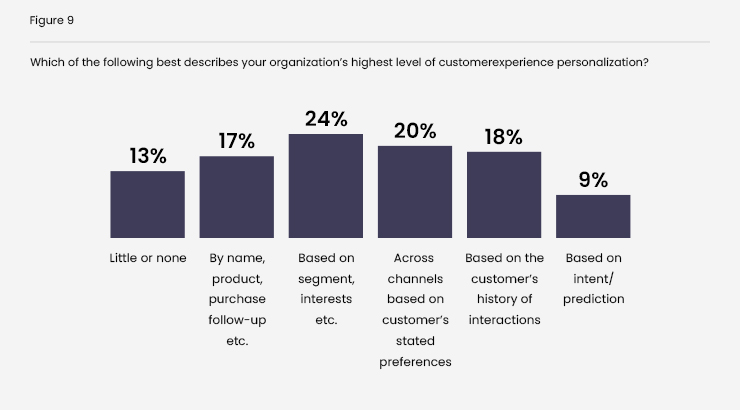
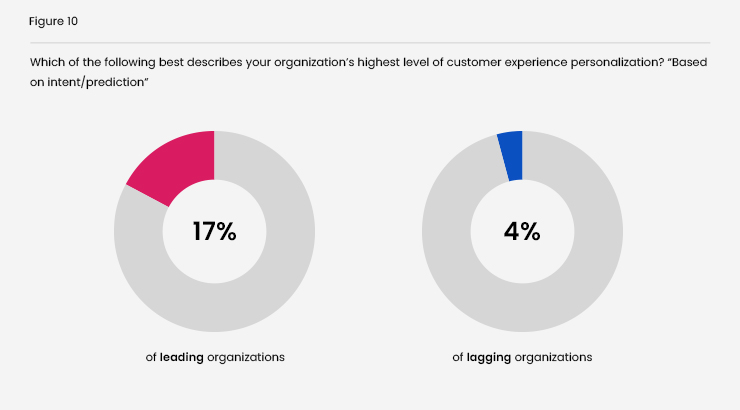
According to a recent study, 75% of experienced leaders are expanding their existing personalization efforts at scale. For organizations that are less sophisticated in this area, advancements in customer data platform (CDP) technologies, with out-of-the-box, low-code capabilities, make it easier for them to achieve higher-order personalization and fast-track their CX maturity, provided they can connect their unified data from a CDP to their systems of engagement that can deliver on customer demands in real-time.
The Importance of Customer Data Platforms for Real-Time Customer Experience
- To manage customer data in real-time and leverage AI-generated signals on intent and prediction, organizations need a strong foundation. However, according to a study, organizations are still struggling with first-party data activation.
- Customer data platforms (CDPs) are essential for fast-tracking CX maturity, but many organizations still struggle to transition from outdated data management platform (DMP) solutions.
- 50% of practitioners and senior executives still rely on multiple technologies for customer experience operations without a unified platform, which impairs their ability to assimilate, interpret, and activate customer data.
- With the resurgence of physical retail, it will become even more challenging for organizations to connect the dots across customers’ journeys. Therefore, today’s CDPs need to aggregate real-time customer behavioral data from online, offline, and third-party sources to create rich customer profiles that can serve as the foundation for personalized customer interactions.
- An outdated experience infrastructure will make it virtually impossible for organizations to achieve this goal, which could be a major roadblock in providing effective, real-time customer experiences.
The Cost of Efficiency: Lack of Time for Creativity Hinders Exceptional Customer Experiences
According to a recent study, time and freedom to be creative are crucial for teams to design exceptional and value-driven customer experiences. However, the study found that a significant number of organizations do not have the time for creativity, with 62% of senior executives agreeing that their organizations have become more efficient but at the cost of creativity. This is considered a major internal barrier for CX practitioners, with 44% citing lack of time to be creative. Lagging organizations are more likely to face this challenge, with over half of them considering the lack of creative time a key internal CX barrier. Despite this, organizations can unleash the creative potential of their employees with the help of technology and other resources.
The Importance of Balancing Data and Human Insights in CX Creativity
- Balancing data and human insights is crucial for creating exceptional customer experiences
- Only 22% of practitioners excel in balancing the emphasis on data/algorithmic ‘truth’ with human insights
- Only 22% of practitioners excel in combining customer understanding with creativity
- Leading organizations show a higher level of proficiency in weaving customer insights into their content and campaigns compared to lagging organizations
- Collecting data about customers is not enough for creativity, and marketers need to establish meaningful, emotional relationships with customers
- Marketers need to enrich customer data points with human truth, insight, and empathy to foster creativity in their campaigns
- Creating exceptional customer experiences requires customer insights, time, and dedicated creative focus.
The Benefits of Content Workflow Automation for Marketing and CX Teams
- Content workflow automation is becoming a top priority for senior executives in marketing and CX teams.
- Streamlining or automating collaboration and processes to work faster and better is a top CX priority for 39% of senior executives.
- Achieving greater efficiency through automation is a top operational priority for marketing or CX in 2023 for 38% of senior executives.
- Automated tools using AI can handle dynamic sizing, versioning, essential edits, and optimizations, reducing the workload for teams.
- Smart tagging of content assets can save time and effort in searching through marketing material.
- Automating time-intensive creative tasks can free up time for high-value creative thinking.
The Secret to Success in the Customer Experience Frontier: Bold Experimentation with Web3 Technologies
Senior Executives Still Learning about Opportunities in Customer Experience Frontiers
The majority of senior executives are still in the early stages of integrating customer experience frontiers into their strategies. About one-fifth of them are still learning about marketing in the metaverse and using NFTs in marketing and CX. Over half of the senior executives do not believe that such blockchain innovations will apply to their organization in 2023. Though the future of customer experiences remains a challenge for organizations, it is also a dynamic opportunity. The metaverse has the potential to generate up to $5 trillion in value by 2030. Private equity and venture capital investments in Web3 deals have grown by around 70% per year from 2017-2022. However, disruption among major metaverse players and cryptocurrency exchanges also poses concerns.
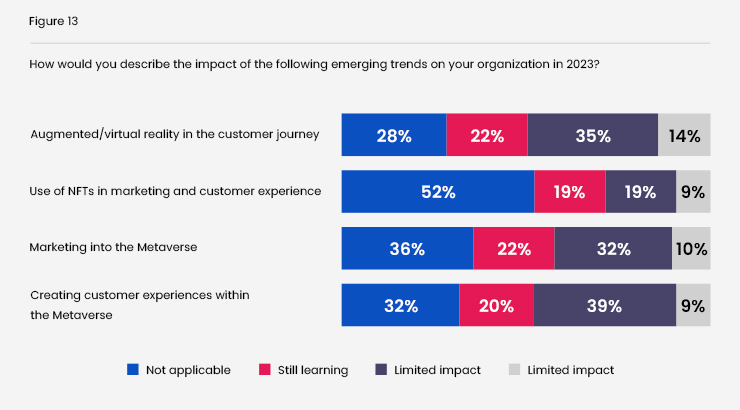
The success of the organizations in the customer experience frontier lies in meeting their customers’ changing preferences in new and exciting ways rather than copying existing ideas. The pioneers in the Web3 space are still testing and experimenting with new technologies to create new customer relationships and revenue streams. Successful organizations will keep a close eye on their customers’ evolving preferences and behaviors and create conditions for true creativity and exploratory thinking to prepare for future possibilities. These organizations will approach new technologies as experiments, gather learnings and create a solid technological foundation, and launch platforms that bring existing and new channels together. The good news is that fast-tracking progress and catching up with the pioneers is possible. The suitable title for the same could be “The Secret to Success in the Customer Experience Frontier: Bold Experimentation with Web3 Technologies.”
Does your website have the potential for success? Find out with our free assistance!:
Conclusion
The digital economy presents limitless opportunities for organizations to gain significant returns by delivering exceptional customer experiences. To succeed, brands need to prioritize long-term customer goals, streamline content teams and workflows, stay in step with customers, create time for creativity, and prepare for new possibilities. This requires imagination, overcoming obstacles, and bringing humanity to bear in new and creative ways. Leading brands in 2023 will respond to customers’ needs with warmth, empathy, and understanding by improving real-time, individual-level data access and enriching data points with customer insights. Organizations must create a culture that is comfortable with imperfection across new channels and platforms and ready to learn from experimentation.

